The monarch butterfly migration of 2021 has begun, and based on reports from Canada and sightings of the iconic insects in San Antonio and the Texas Hill Country, the insects are running strong.
“Two of us spent about one hour in the late morning and one hour in the afternoon capturing monarchs,” reported longtime monarch butterfly tagger Donald Davis from Port Hope, Ontario, on August 20. Davis said he and a friend tagged 164 butterflies at a clover field near Lake Ontario. “Almost all monarchs captured were in pristine condition,” he shared via the DPLEX list, a monarch enthusiast email group with hundreds of members.
Citizen science organization Journey North, which tracks the monarch migration and others, reported sightings of a handful of roosts as of this writing.
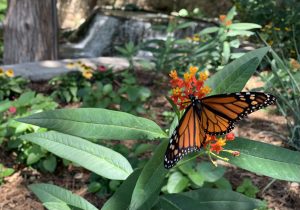
Monarch butterfly on Tropical milkweed this week on the San Antonio River Walk. Photo by Juan Guerra
“First monarchs that I’ve observed in an annual roosting location near Tobermory, Ontario, Canada,” an observer identified as Peter noted on August 20. He added that the roost of about 200 had island hopped across Lake Huron and were “resting/fueling up for the next leg of the journey.”
The next leg of that journey will bring the international travelers through San Antonio and what’s known as the Texas Funnel in September and October. Peak monarch migration occurs at our latitude October 10 – 22–just in time for San Antonio’s sixth annual Monarch Butterfly and Pollinator Festival, which takes place this year October 16 at Confluence Park.
During the migration, monarchs typically nectar on flowers in the morning, fly during the day, then drop from the sky in the evening to roost overnight in groups. Check out Journey North’s live migration maps here.
Dozens of monarch butterflies have been spotted along the San Antonio River in downtown San Antonio in recent weeks. Numerous accounts of monarch eggs, caterpillars, adults– even native milkweeds–have been reported, unusual for this time of year. Typically such sightings occur in these parts around Labor Day, and are known as the “premigration migration.”
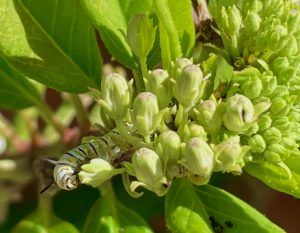
Num num num. Monarch caterpillar chows down on Texana milkweed in San Antonio, Texas on August 20, 2021. Photo by Drake White
“I’ve had Monarchs scouting the milkweed for the last three weeks,” said Drake White, owner of the San Antonio native landscaping firm The Nectar Bar. “I’ve noticed changes in many of the butterflies this year, and in several butterflies showing their Fall form in July! I think we’re in for an early winter,” she said.
So what’s the forecast for this year’s migration?
Chip Taylor, founder of citizen scientist organization Monarch Watch, which celebrates 30 years of studying, tracking and tagging monarch butterflies this fall, wrote recently that conditions appear “favorable for a large migratory population that could rival that of 2018” for monarchs east of the Rocky Mountains. That year, the monarch population jumped to a healthy 6.05 hectares/15 acres at the overwintering sites in Mexico where numbers are counted annually.
Taylor expressed concerns about monarch numbers from the eastern Dakotas and western Minnesota since those areas “have been much warmer and drier than is generally ideal for monarch population development.” He laid out his forecast in an August 17 post on the organization’s blog.
He added that perhaps due to adequate rainfall and moderate summer temperatures, monarchs are much more abundant in Oklahoma and Texas right now, and suggested that large numbers of monarchs could join the migration from those states in late September and October.
“The September temperatures are still a question,” he wrote, “but there is no evidence of a drought in Texas or elsewhere that might diminish the possibility of surviving the passage to the overwintering sites.”
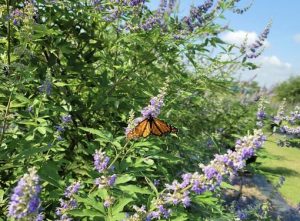
Monarch Butterfly spotted at Texas Tree Farms in Waxahachie, Texas on August 16, 2021. Photo by Austin Rollins, Texas Tree Farms
“There is every reason to expect a larger overwintering population in Mexico this year than seen during the last two winters,” he concluded.
That is not the case for the western monarch population, which has suffered severely this year.
“In the West, the prospects for an overwintering population of more than a few hundred monarchs along the California coast appear to be slim at best,” wrote Taylor, citing extreme temperatures, drought and wildfires.
Karen Oberhauser, director of UW-Madison Arboretum and founder and director of the Monarch Larva Monitoring Project, agreed with Taylor’s upbeat assessment of the eastern migration.
“Based on egg and larva data collected by MLMP volunteers and sightings by butterfly monitors, my guess is that things will be better than last year,” she said via email. “But a lot can happen between now and then,” she added, referring to the myriad variables that factor into the migration’s success: wildfires, hurricanes, cold snaps, heat waves, and human interference such as aerial pesticide spraying.
Andy Davis, migration studies expert at the Odum School of Ecology at the University of Georgia, declined to comment.
Thousands of citizen scientists tag monarchs each fall. They capture migrating butterflies in nets, adhere a tiny sticker to the discal cell of their forewing, record the butterfly’s sex, the date, time and place of the tagging, and report the data to Monarch Watch. At this year’s Monarch Butterfly and Pollinator Festival in San Antonio, organizers will continue a tradition begun last year in response to COVID deaths known as the Forever Journey campaign. The initiative tags each butterfly in honor of someone who died.

FOREVER JOURNEY: Want to honor someone who died? Fill out the form at the link above and we’ll take a butterfly in their name. It’s FREE.
For those unaware, monarchs either migrate or mate. They don’t have the energy to do both. The butterflies that spend their winters in the Mexican mountains experience what’s called reproductive diapause–that is, they postpone all reproductive activities until spring.
That’s when the multi-generation migration begins, as monarchs move north in search of milkweed on which to lay their eggs. The cycle continues throughout the summer as the first generation gives way to the second, until the fall when fourth and fifth generation monarchs get cues from the sun that alert them to start heading south.
Here in the Texas Funnel, mild summer temps and regular rain following the historic freeze in February that knocked out many nonnative plants has resulted in an unusually robust early monarch season.
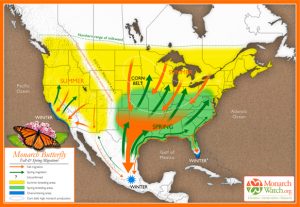
“It’s definitely a crazy year,” said Jennie Singleton, longtime monarch tagger and docent for the city of Grapevine’s Butterfly Flutterby Festival. “Normally I get caterpillars in mid September ahead of the big migration. This year there have been caterpillars since the first of August.”
Singleton said since returning from a summer road trip on August 13, she’s found caterpillars every day.
In Comfort, just outside San Antonio, Cathy Downs, an outreach specialist for Monarch Watch, reported no sightings of monarchs or larvae since late July. “My Asclepias asperula milkweed has senesced here,” said Downs, referring to Antelope horns milkweed that typically blooms in the spinrg. “I had some larva on Asclepias texana in late July. I was hoping for a 2nd emergence as I missed my harvest. Fifth generation [monarchs] is getting to be a regular thing in Texas for several years now.”
TOP PHOTO: Monarch butterfly at pollinator garden in downtown San Antonio’s Nueva St. bridge on August 14, 2021. Photo by Monika Maeckle
Related Articles
-
- Two monarch butterflies tagged on the LLano River in honor of lost loved ones recovered in Mexico
- Save the date: Monarch Butterfly and Pollinator Festival returns Oct. 16 to Confluence Park
- Three monarch butterflies tagged at 2018 Festival recovered in Mexico
- Documentary chronicles year of chaos through lens of monarch butterfly migration
- A monarch at my Abuela’s Day of the Dead altar
Like what you’re reading? Don’t miss a single article from the Texas Butterfly Ranch. Sign up for email delivery by subscribing below, or follow us on Facebook, Twitter, or Instagram.

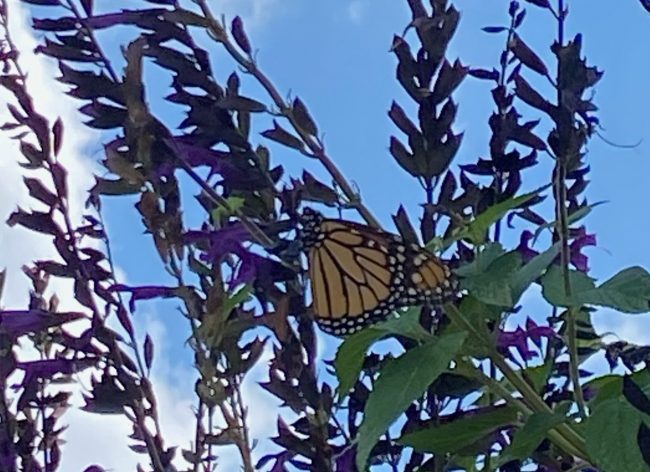
So glad to have your report. Deep thanks to all volunteers who support and track these beautiful amazing creatures.
Meg from Massachusetts
Thanks for reading and writing! —MM
I live in central Ill i have monarchs come throught in the fall i haveso many questions. Can you help.
I live in NE Ok. and have had lots of Monarchs these past 2 weeks. I’m thrilled.
The biggest problem I have is the tachinid flies. Its so sad to see.
Anyone have any suggestions to avoidd it?
I have a huge garden of common milk weed and some swamp and butterfly weed.
I’ve found 5 cats this am!!
Thanks for the great newsletter.
Good luck with the tachinid flies. Yes, always sad to see these bodysnatchers. Thank you for reading and writing. —MM
I put potted milkweed in a mesh enclosure that my husband made for me. (You can also purchase them online.) I leave the milkweed outside for a few days and let the butterflies lay eggs on it. Then I put it in the enclosure. (Occasionally I get a volunteer milkweed that my hubby digs up and I put in the enclosure, see my comment below.)
I agree, it is sad to see. You can also research and try fly traps. I don’t like because they trap all flies, many of which are good flies. The tachinids are attracted to the pheromones that the caterpillars have when they are ready to j-hang. I see them buzzing around the enclosure at that time. But I also know they attack even the smaller cats. So sad.
I had this problem too, what I suggest is look for caterpillars in their 1st instar and eggs. Caterpillars in their 1st instar have most likely not been infected along with the eggs. I purchased encloses for my caterpillars and cleaned their enclosure and picked milkweed stems twice a day. Ever since then I’ve had healthy and happy caterpillars.
Lyn here from Nova Scotia, Canada. Lat 44.3 long. 64.01 Atlantic coast. So far have raised and reléased 170 adults over past week that were in outdoor tents. Of those i have tagged 50.
Have a few more to go. Found a few small cats recently but not many. Eggs appeared here in early July and are now adults. Nothing much after that. This is unusual. Normally eggs appear last week of July here.
Yes, it seems that everything is running several weeks early in these parts. Thanks for reading and writing. — MM
So glad to hear that things are looking good for the eastern migration!!
Here on the west coast – I’m near San Diego CA – I have been noticing the usual amount of butterflies. Yet the caterpillars I bring in to my enclosure from outside are 100% infested with tachinid fly larva. I raised many butterflies from egg in the spring and released them. A few weeks ago I found a volunteer milkweed with eggs and tiny caterpillars, so I raised them. Just released 7 butterflies yesterday, looks like two more today. But in the process, I had to buy more milkweed – some of which had more caterpillars. Sadly, many of them had the dreaded maggots.
Thank you for a most interesting report that highlights the simple wonder and glory of one of God’s creations!
Hi from Kingsville Ontario on the north shore of Lake Erie. North of Sandusky Ohio. our year started slow but kicked in to high the middle of July. I collected eggs at first sight and just released number 23. Collected more eggs on August 21 st many have hatched so hope to have a late group coming your way. others in our are area are active in hatching Monarchs we will keep forwarding these amazing things as we can
I’m in Austin and I have LOTS of Monarchs in my yard feeding from my flowers. I do have lots of milkweed that have lots of caterpillars. I’m new to this with my butterfly garden and it seems to be going great so far.
I’m relatively new to this, in the Houston suburbs. We have a native monarch population, and I’ve read that that population should not be encouraged, so I generally keep my milkweed in enclosures to grow, until I read that the Spring/Fall migratory waves are passing through.
It makes sense that the Spring wave(s) would need my plants to reproduce. But what about the Fall wave as it passes through Houston? Are they ALL In diapause by the time they get here? Or am I just supporting the native population in the Fall with my milkweeds?
Bonus question, please: is a larger, more genetically-diverse native population such a bad thing?
Bernie, I’m in Conroe and there’s a Houston FB butterfly group that argues this concept all the time. I too keep my milkweed away from Monarchs for most part of the summer. I keep my milkweed out only for Mexican traveling mamas. They came to me mid March this year. I raised until about June and stopped. I switched to Swallowtails. But then, there’s always that one sneaky Monarch mama who somehow gets on my plants and egg bombs me. I’m dealing with that now. But in August, am I raising the natives or the children of the migrators? I’m not really sure. I don’t think the fall migration is in our area yet. They say September? Last year, these late Monarchs wanted to dump eggs all over my milkweed. I swear to you, those children I released were so big and flew straight up to the sky! I’m learning too. I hope someone can help us with this.
Hi Jessica. I’m from Austin. I’ve been studying what others have written about monarchs and their habits over the last 50 years and have been raising them myself regularly for about 20 years and have some opinions of my own. The most visible monarch “scientists ” use the words “we think” “maybe” “could ” “we aren’t sure” a lot. Monarchs make individual decisions as to when they lay their eggs and what kind of milkweed they lay them on. Monika interviews a number of different “visible” monarch people in her articles and it demonstrates their difference of “opinion”. My opinion, which I consider is as good as any ones; Plant all kinds of milkweed and nectar producing plants in your yard where and whenever they will grow. If you find a monarch egg on a milkweed plant cut the stem it’s on making sure you leave lots of leaves, immediately put it in water, and put it in a window in your house in a netted popup if you have one. If you need to, add another stem with fresh leaves until that caterpillar transforms itself into a chrysalis. Now you can wait a dozen days or so and that chrysalis will produce something that in no way resembles the caterpillar it once was. Let your butterfly dry and gain strength for about 24 hours. Now you can take it outside and release it. That egg would have had less than a 5% chance of becoming a beautiful in flight adult butterfly if you would have left that egg outdoors on that plant. If it’s a female, stays in Houston, and lays its eggs, it’s October and flies to Mexico for a winter vacation or not , or it’s April and she decides to fly to Iowa to lay her eggs, you will never know unless you put a tag on it’s wing then you have a small chance of hearing about it again. There will be those that get to see her and enjoy her as she flies by or lands on a flower near them. After all my studies, I can’t name one person who can tell you what decision the butterfly you saved will make. What I do know is every time I release one, and a lot of people think that I release too many, I think I helped add a little beauty to somebodies day.
Thanks! It seems like there is no consensus. The most common sense answer would appear to be that more is better than fewer, so maybe I’ll keep the milkweeds uncovered next Summer. Besides, they didn’t look very healthy when I removed them from the enclosures.
Bernie….. Adult monarchs feed on many different kinds of nectar producing plants, salvia being a very popular one. Also try sedums and agastache. It is only at the immature stage that monarchs need milkweeds, although they do like it at the adult stage too.
I live in Northbrook, IL. A good friend, Marilyn Fish, has started a program called “Monarchs, Milkweed and More” that has really taken off in our community. She has transformed our landscape with a very successful native plants program. Keep up the good work in Texas, and thank you for sharing your ideas and information!
From what I’ve read about non-native milkweed (like tropical Milkweed from the Caribbean being grown in places like Florida), it seems to tempt the Monarchs to not migrate which is deemed detrimental to the survival of the species. Places like Aruba have lush milkweed plants and non-migrating Monarchs, so the current thinking is to plant only native Milkweed from your area in your outdoor garden, and leave the more lush non-native species from seeds you collect or purchase to the indoor areas or greenhouse.
In NYC, we see a few Monarchs – (and as this part of the US is one link in the migration chain, it is important that no links get removed) and I was elated when one butterfly recently visited my 9 milkweed plants in my small garden but so far have seen no evidence of caterpillars. Only 1 neighbor of mine is also growing milkweed in their garden that I know of, so we need to work on that. NYC’s Rain Gardens which are popping up on nearly every street often have swamp Milkweed planted there (on purpose) which is very encouraging. https://www1.nyc.gov/site/dep/water/rain-gardens.page
On some of the islands in NYC (like Randall’s Island) and in NYC’s Central Park and in parts of the Brooklyn waterfront area like in Spring Creek park https://www.nycgovparks.org/parks/spring-creek-park-b165 there is lots of native healthy milkweed growing. All good signs, but we need more to replace the billions of plants that used to grow all across this country.
Recently took a drive into Western NY, Ohio and Michigan and was quite happy to see the great diversity of wildflowers growing along the highway. So it appears that with help from state, local and Federal levels there is a small to fair chance that our Monarch migration will be viewed and enjoyed by the next generation too.
But encouraging signs are just that. The Monarch populations remain under great threat with over 90% gone in the West and as much as 80% gone in the East. It is important to realize that there will never be a Federal declaration to save the Monarch. If they die out, it will happen on our watch and there is nothing in this legislative environment that will help them. That means it is up to us to tackle this.
We all need to all do our part (outreach to neighbors, emails, social media posts, seed collecting, seed planting in the fall, seed-sharing, youth events, even sending encouraging and educational Monarch & milkweed related information to any parents of children you are in touch with) to help plant more native milkweed in our gardens and empty lots and consciously work to end our reliance on toxic herbicides & pesticides.
I have watched tens of thousands fly over my home in Oro Valley, Arizona over the past few days. So cool to watch.
Very Southwest corner of Oklahoma here. We noticed the Monarch migration started about 10 days ago, which seems earlier than usual. We’ve also noted the Monarchs seem larger and healthier than prior years, fingers crossed that others are noticing this too.
We’ve probably had 40 or so Monarchs eating nectar from our abelia plants today, but expect many, many more as the migration increases.
Sending them your way with a prayer on their wings for a safe arrival.
I live in Central NY and I have spotted more Monarchs this Summer/Fall than I have seen in a long time. Every year we plant a lot of Mexican Sunflowers, (tithonia), in our yard. We love these flowers because they will grow 6-7 feet tall with LOTS of blooms and the Monarchs LOVE them! They are a great source of energy for that long trip. Just something to consider if you are looking for a food source for the adult butterflies.
2 sightings today 1 past several days location arizona yavapai county town of Rimeock. Arizona . Attraction native yellow daisies blooming.
Thank you for your web site.
Thank you for reading and writing. -MM
This is my first time rearing monarchs. My three year old son and I cut pieces of our milkweed once we noticed caterpillars on them and put them in an enclosure. We even noticed some tiny caterpillars as well as eggs on the milkweed leaves upon closer inspection. From the time we started 9/29 until now , we collected 13 cats and all are in the chrysalis stage now. We have 2 that have turned black and. we’re waiting for them to emerge. I wish I had known about tagging sooner, I would have loved to do this. We’re hoping all our cats have a successful transformation into beautiful monarchs.
-Lea & Bryce Belletz
I live in Santa Fe TX and just this morning a male monarch butterfly emerged out of his chrysalis. I have 15 still in their chrysalis will these butterflies migrate to Mexico? Over the last 2 weeks I have released about ten and I have had a couple of females still laying eggs and its October. I live on 2 1/2 acres and now have milkweed everywhere so its not like I can stop them from laying eggs.I have 3 inch long cats right now but they seem to be growing really slow and very sleepy like is this normal bc its cold outside. Should I bring the eggs inside and still try to raise them to butterfly. It is so late in the season not sure what to do.I also have the moth that looks like the monarch on my milkweed right now it’s in caterpillar form do they chrysalis like the monarch?
I just saw two monarch butterflies mating outside of Austin, TX. Thought it was strange since we’re in December now.
I saw a monarch butterfly in our backyard here in Houston this week. A huge butterfly and it landed on a milkweed plant in bloom. December 9, 2021 Near Lake Houston